Welcome to the first issue of the ISIS Small-Angle Neutron Scattering (SANS) newsletter for 2024. Since our first newsletter in 2022, lots has happened here at ISIS, on the SANS instruments, and in our group.
The current cycle has seen the return of both target stations to full running. The hydrogen moderator on TS2 has been upgraded, giving around 20% more flux on Larmor, SANS2D, and Zoom. The hydrogen moderator on TS1 has been successfully replaced, meaning that LOQ is now operational and with around twice the flux. It will remain out of the ISIS programme due to a lack of staff resources but will be used for Xpress measurements, testing and training.
Keep reading to find out the records we have recently broken for lowest temperatures and smallest sample volumes studied on ISIS SANS instruments.
The next ISIS proposal round has opened, and you can now submit proposals until the deadline of 17 April 2024 at 17:00 UK time.
If you have any questions, comments or wish to contribute then please contact one of the team. You can find more information about the us on our web pages or contact us by email at SANSgroup@stfc.ac.uk.
In this issue:
Instrument updates
Software updates
Staff news
Events
Science Highlights
Instrument Updates
The three TS2 SANS instruments (Larmor, SANS2D, and Zoom) continue to run a full user programme, using a range of sample environments and SANS variants. LOQ has returned to operation with the replacement of the TS1 hydrogen moderator and has been used for operational tests so far.
Larmor
The ISIS SANS Group together with the ISIS cryogenics team has made significant progress in enhancing our sample environment capabilities. On Larmor, we achieved the low-temperature record on an ISIS SANS instrument reaching 35mK above absolute zero last summer. This achievement enables ultra-low-temperature research investigating quantum phase transitions that are otherwise covered by thermal fluctuations, like quantum spin liquids and heavy fermion superconductivity. Dilution refrigerators are a common sight on muon instruments, inelastic spectrometers and diffractometers to study quantum states in materials. Now, thanks to the effort of the ISIS cryogenics team this ultra-low temperature capability is available for SANS and puts the sample environment suite on par with other neutron research facilities.

The Larmor SESANS setup continues to show great stability, returning to nearly the same tune point even after being disassembled between cycles. The count rate possible with SESANS has dramatically increased (nearly 100x) with a new scintillator detector provided by the ISIS Detectors Group. This brings the performance of the instrument up to the levels originally anticipated for the technique but which had been limited by detector saturation effects. Excitingly there may still be room for further improvement with the potential for another factor of 2 if the detector technology can be improved further.
SANS2D
Sans2d continues to push the sample environment envelope. Earlier this year, Prof Yujun Feng (Sichuan University) and co-workers studied the formation of a bicontinuous microemulsion in a microfluidic chip they had fabricated. Though this was not the first such device to have been used on Sans2d, the experiment was notable for scattering from the smallest sample volume yet studied on the instrument: just 1.8 mm3. The finely collimated beam passing through a channel 500 micron wide by 500 micron deep. The image below shows the chip mounted against a quartz glass heating plate that provided the temperature control
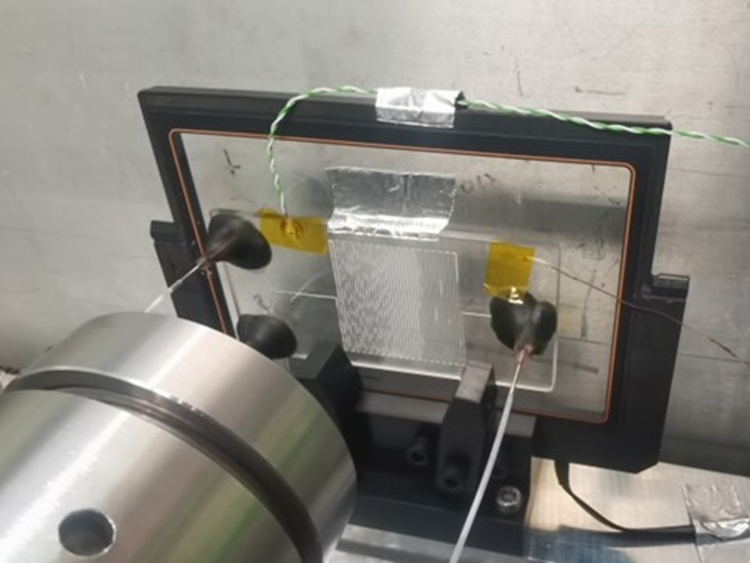
Zoom
In collaboration with Bana Shriky and Tim Gough from Bradford University, a variety of shear sample environments were deployed on Zoom, including a mixed flow syringe device for studying how hydrogel structures develop under mixed shear and extensional flow as temperature is increased following formulation injection: a 1,2 plane shear rheometer (adapted and improved from a NIST design) and a cross-slot extensional flow device. The image below shows the 1,2 plane shear rheometer with temperature control through a water bath.
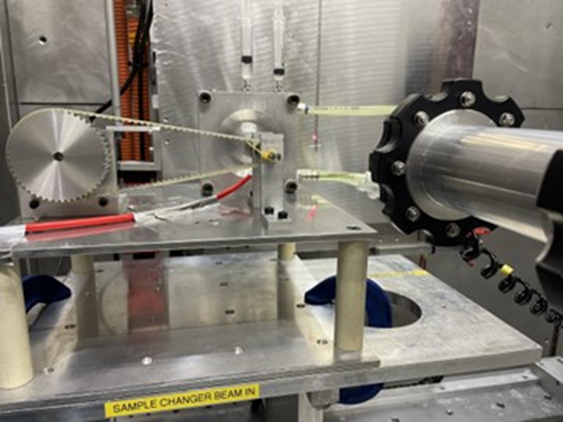
LOQ
As readers will be aware, Target Station 1 shutdown in July 2021 for the Covid-delayed refurbishment of its TRAM (Target, Reflector and Moderator) assembly. There is more information on what was involved on the ISIS website.
The project was expected to be complete within a year, but in the event, and only after a lot of work by a huge number of people, neutrons returned to TS1 the week before Christmas 2022. Loq was the first TS1 neutron instrument to be cleared for beam. Thus the SANS Group broke for the holidays looking forward to the recommencement of TS1 operations in February 2023. Alas, early in the new year it became apparent that there were issues with both the new methane and hydrogen cryomoderator systems. The methane system was brought into operation relatively swiftly, but the issue with hydrogen system (supplying cold neutrons to Loq, Surf, Crisp, Osiris and Iris) proved more problematic to diagnose and fix. Eventually, the decision was taken to swap the moderator vessel for a re-engineered unit. That changeover was deliberately delayed to give other instruments the chance to reduce their experimental backlogs, to give the methane system time to bed in, and to allow the moderator team time to prepare and test. Thus, it was not until January 2024 that the replacement hydrogen moderator was installed, and it did not become operational until February (Cycle 23/5). At the time of writing, we are now in a period of operational testing to confirm that the new cryomoderator system is operating as expected and, as importantly, is stable, whilst characterising its spectral properties, and monitoring that the TS1 Experimental Hall remains a safe working environment. But so far, so good.
Unlike the old hydrogen moderator, the new moderator has a water pre-moderator placed between it and the target in a similar way to the TS2 design. This boosts the long wavelength performance at the expense of a modest relaxation in the spectral width. Preliminary analyses of the data taken suggest that the new moderator and redesigned neutron target are now delivering a factor ~2 increase in neutron flux across the Loq wavelength band compared to the pre-refurbishment baseline. As long-time Loq users will appreciate, this is obviously a significant and very welcome development.
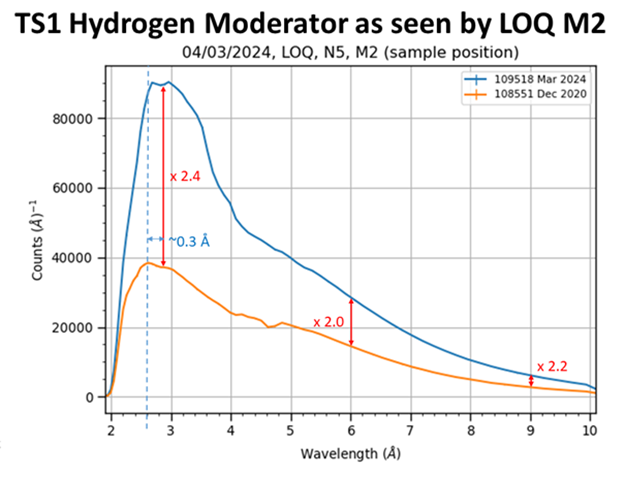
Changes in the materials in the new TRAM assembly have also reduced the depth of dips in the spectrum, and slightly shifted the spectral peak to longer wavelengths. A practical benefit of the latter, aided by the improved flux, is that the Loq chopper can be rephased to shift its window to slightly longer wavelengths than before, thereby improving low-Q performance. Preliminary indications are that a minimum Q around 0.0055 Å-1 will be realisable compared to ~0.007 Å-1 before, albeit with a small reduction in the maximum Q from ~1.4 Å-1 to ~1.2 Å-1. But the old configuration will remain available for those that require it.
Software Updates
IDAaaS (ISIS Data Analysis as a Service)
A major work in data management was in preparation by the IDAaaS team since last year. There was an upgrade of the system from CentOS7 to Rocky 8 Linux, which included a redeploying of all scientific software installed on IDAaaS. Then, there was the disconnection of ISIS archive in favour of ISIS Instrument Data Cache, which is in alignment with ISIS Data Policy.
A test environment took place in Jan/Feb 2024, so each beamline or group had the chance to request necessary adjustments. IDAaaS users might have needed to update the paths for some old shortcuts. Other than that, all is working well. The SANS group takes this opportunity to invite you to continue using IDAaaS workspaces to reduce and analyse data after your beamtime
Mantid
Since the last SANS Newsletter the Mantid Framework has advanced from v6.5.0 to v6.9.0, and all users of the program are encouraged to update to it. For the full list of changes, make sure to read the Release Notes.
Broadly speaking, each new version contains a mix of four types of improvements: essential code maintenance (like changes to Python versions and other dependencies); 'core' enhancements (to things that help everyone, like file i/o, plotting, etc); bug fixes at both the framework and technique-specific levels; and new functionality.
Of the latter improvements, it is now possible to perform a 'scaled background reduction' from within the SANS Interface Reduction Table, whereby only some fraction of the Can background is subtracted. For more information, ask your Local Contact. Work is also currently underway to provide Polarised-SANS users with a more holistic data reduction experience. The first elements of this should be available in v6.10.0.
Another change being implemented for all users of Mantid concerns the Error Reporter, the window that pops up when something goes badly wrong. Starting with v6.9.0 it is now mandatory to provide an email address in order to submit a bug report. This change has primarily been made to enhance the value of bug reports to the Development Team, who may now contact you for further clarification, but in the future, it could also be used to provide, for example, automated updates on the progress of your bug report, strengthening the software-stakeholder feedback loop and improving everyone's user experience. So, please, do help us to help you by submitting useful bug reports.
SasView
SasView v5.0.6 was released in June 2023, and all users of the program are encouraged to update to it. For the full list of changes, make sure to read the Release Notes.
Please report any issues when installing/using the program to the usual help@sasview.org or, if you prefer (and have a GitHub account), complete a bug report.
Whenever reporting back, please make it clear which version of SasView you are running, which platform you are using (Windows, Mac, etc), and also your specific operating system version (which seems to be increasingly important with Macs). Equally, it would also be great to hear if you are enjoying the program and finding it useful. 'Silence can be Golden' as the saying goes, but the Development Team are never quite sure if it is good or bad.
At several recent conferences, including SAS2022 in Brazil for example, the small Development Team have been asked several times how the program user base can contribute. SasView is a community development effort, although it is always amusing when emails are received that quite clearly believe it to be the product of a software house with dozens of developers. Some of the low hanging fruit identified in these discussions were in documentation (verification and editing of the program and model help files, writing and recording tutorials, etc) and helping to test new releases. But, of course, Python ninjas are equally welcome. So, if you can spare a little of your time, as and when (no everlasting commitment is expected) then please get in touch.
In this vein, at the end of January 2024 SasView staged its best-attended Contributor Camp yet: over 30 people from 15 institutes took part. You can read a report about this event on the SasView website.
At the time of writing, the Development Team are deep into putting the finishing touches to release v6.0.0. Among the many updates will be the return of the Orientation Viewer, a completely revamped Correlation Function perspective, and improvements to 2D data slicers and the Generic Scattering Calculator. It is hoped the new release will be out before the summer.
But to keep abreast of developments, keep an eye on https://www.sasview.org/ or join the (moderated) User mailing list at http://lists.sasview.org/cgi-bin/mailman/listinfo/users.
SANS Data Reduction and Analysis
As a reminder, we do have some online guidance and tutorials to getting the most from your data reduction and analysis.
Staff News
Though not formally a member of the SANS Group, Lucas Wilkins is a software engineer in the ISIS Research Software Engineering team with special responsibility for SANS data analysis and SasView in particular.
Lauren Matthews recently started as a new Instrument Scientist in the SANS Group. Before starting at ISIS, she was the beamline scientist on the ID02 time-resolved USAXS beamline at the ESRF in Grenoble. Outside of beamline duties, Lauren has an interest in poking soft matter and colloidal systems with various forms of radiation, to probe structural details in gels, microemulsions, and lipid systems. In particular, she is interested in this combined with a rheometer, or doing stopped-flow rapid mixing experiments. Outside of science, she likes winning board games (rarely happens), binge watching Netflix series, and running after her cat.
Events
ISIS 40th Science Roadshows
To celebrate the 40th anniversary of neutron science at ISIS, we will be hosting a series of science roadshows across the UK throughout 2024. Information about the events and their programmes is available for the Belfast, Cardiff, and Edinburgh roadshows; updates about the Manchester and London roadshows will come later in the year.
Science Highlights
ISIS regularly publish Science Highlights on our website, and below we include a few recent ones from research arising from the SANS Group.
Using neutrons to understand the skin barrier
Researchers from Leiden University in the Netherlands have come to ISIS to improve understanding of the molecular differences between diseased and healthy skin. Read more...
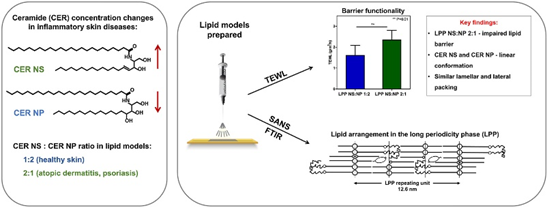
You've got nano-mail. The role of SANS in lipid nanocarriers
Researchers from Prof Molly Stevens' group at Imperial College London and Karolinska Institute with scientists from ISIS have exploited several techniques to gain structural understanding of lipid-based particles to support their clinical applications. Read more...
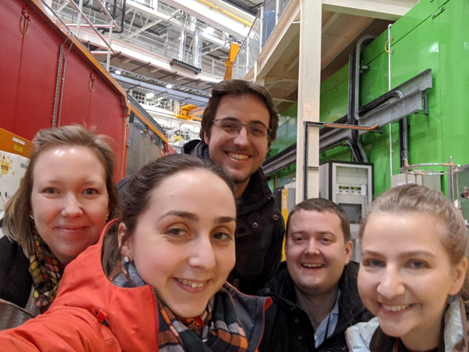
Nature Knows Best- how the use of geometry in biology could be applied to materials science
Biology makes use of geometry for efficiency in many areas in order to achieve optimal functioning whilst minimising energy costs. Professor Lorna Dougan and Dr Matt Hughes, along with fellow researchers from the University of Leeds, and ISIS scientist Najet Mahmoudi, formed a team to investigate if protein assemblies are geometrically optimised in the hope that it could help the development of future biomaterials. Read more...
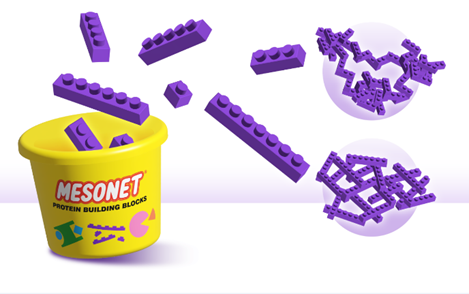
Recent Publications
You can find publications for the SANS Group instruments on the STFC ePubs website. If you have papers that use ISIS SANS data but are not on ePubs, you can add them by logging into ePubs.
Larmor publications
LOQ publications
SANS2D publications
ZOOM publications
